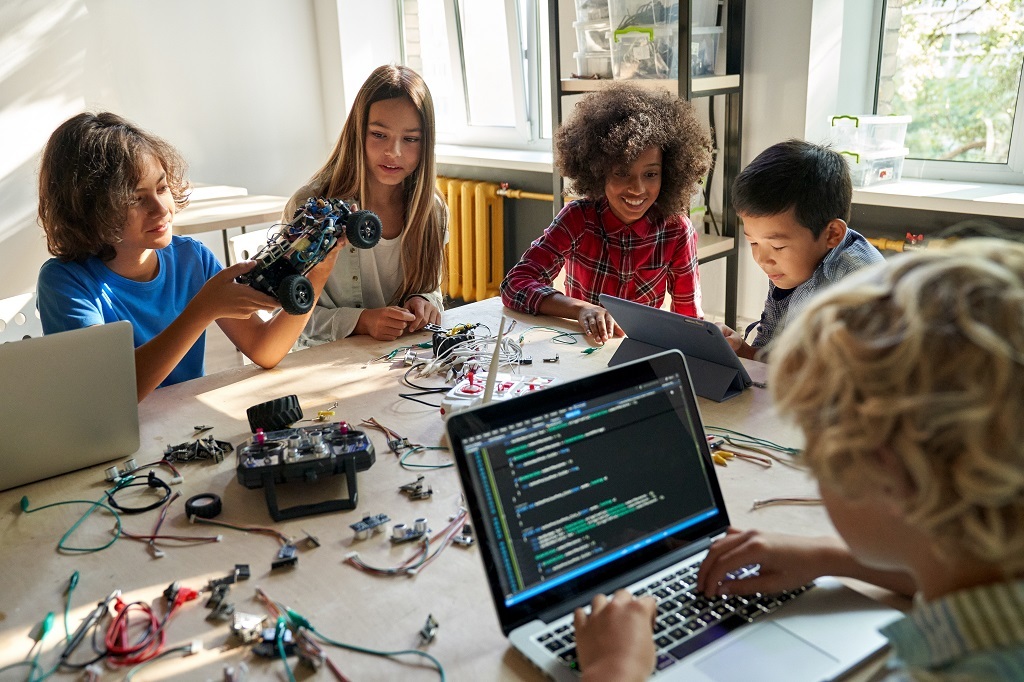From Chalkboards to AI
Empowering Science Education With AI: Enhancing Three-Dimensional Learning
By Christine Anne Royce, Ed.D., and Valerie Bennett, Ph.D., Ed.D.
Posted on 2024-10-11

Disclaimer: The views expressed in this blog post are those of the author(s) and do not necessarily reflect the official position of the National Science Teaching Association (NSTA).
As we navigate the ever-changing landscape of education, artificial intelligence (AI) emerges as a powerful tool that can contribute to pedagogical strategies of how we teach and learn. AI in education, in general, has been met with a wide range of both praise and concerns for its use, and justifiably so. There is no doubt that decisions need to be made that allow educators to use technology to support instruction. (Merrill 2018) In science education, AI can be a value-add tool to instruction, offering innovative ways to engage students in the three dimensions outlined in A Framework for K–12 Science Education (2012). This tool can help students actively explore scientific questions and aligns and assists them in meeting computational thinking targets. Let’s explore how AI tools can be specifically harnessed to teach science, bringing together the skills and experiences that students need with tools that will undoubtedly be used in the future.
Tailoring Instruction
One of the most significant advantages of AI in the classroom is its ability to tailor learning experiences to individual students. Without identifying specific platforms, there are learning platforms and gamification tools that use AI that can help students master skills that are needed in the sciences and contribute to an overall conceptual understanding and the student’s ability to meet the performance expectation.
Imagine a student struggling with the concept of chemical reactions. Why not ask AI what the common misconceptions in the understanding of chemical reactions are and provide a way to teach this topic to overcome these misconceptions? An AI tool can also assist with this and provide additional resources, such as interactive simulations or targeted practice problems, to help the student grasp the concept more effectively. Conversely, a teacher could use AI to create quests or challenges that would help students apply their understanding of chemical processes through real-world examples. Using traditional technology tools, such as an online form that has options for what the next piece of information is based on the answer, teachers can follow the student’s thinking process. One additional possibility for when AI tools can be tailored for the desired learning experience is the use of generating assessment scenarios that require students to use Crosscutting Concepts, Science and Engineering Practices, and the Disciplinary Core Ideas. The use of AI to generate such assessments is already being tested, and the research is identifying the initial considerations of what AI can and cannot do in this area. (Zhai 2023)
Virtual Labs and Simulations
Traditional science labs, while invaluable, often have limitations such as insufficient time and resources and safety concerns. AI-powered virtual labs and simulations can overcome these hurdles, giving students the opportunity to conduct experiments that would otherwise be impossible. Multiple free platforms offer a wide range of virtual lab experiences, from microbiology to physics, allowing students to explore scientific concepts in a safe and controlled environment when they otherwise would be unable to do so.
These virtual labs not only replicate real-world experiments, but also enhance them with AI-driven interactivity. Teachers can use selected example problems or simulations as part of the instructional process, allowing students to change variables, predict outcomes, and receive immediate feedback for supporting their learning. For example, in a virtual lab on ecosystems, students can manipulate factors like temperature and precipitation to observe their impact on biodiversity. This hands-on approach, powered by AI, makes learning science more engaging and informative.
Data Collection and Analysis
When engaging in three-dimensional learning, using the Science and Engineering Practices often involves students in collecting and analyzing data. We are using some AI tools already that help streamline this process. For example, AI-powered sensors and data loggers can automatically collect data during experiments, allowing students to focus more on analyzing the data instead of simply collecting it. It should be noted that while AI can also assist in data analysis, this is an example of when the teacher needs to make instructional decisions and communicate them to students. While AI can do different tasks, there are points at which AI should be shelved so that the students’ learning process is focused.
Another potential use would be to ask students to compare and contrast analyses and interpretations of the same data set. This can be done by giving the students a data set and asking them to analyze and interpret it, then presenting them with the AI’s analysis and interpretation of the same data set. Where are they similar or different? Often, the AI’s data analysis will depend on the quality of the prompt provided, helping the students learn a valuable lesson about the use of AI.
This last strategy also helps elevate the students' cognitive level and assist them in developing critical thinking skills while they learn about the pros and cons of using AI.
Encouraging Critical Thinking and Creativity
AI tools can also encourage critical thinking and creativity, essential components of scientific inquiry. AI-powered brainstorming tools help students generate and organize ideas, fostering creative problem-solving. These tools can prompt students with questions, suggest connections between concepts, and even provide relevant research articles to spark new ideas.
In addition, AI can be used to create interactive storylines or scenarios that challenge students to apply their scientific knowledge in real-world contexts. For example, an AI-driven platform could present a scenario in which students must develop a plan to mitigate the effects of an oil spill. Students need to use their understanding of chemistry, biology, and environmental science to devise a solution, promoting critical thinking and interdisciplinary learning.
It is also important to recognize the connection between generating AI prompts and critical thinking. Creating a prompt is called prompt engineering, requiring the same consideration as the engineering design process. Identifying the desired target outcome, selecting conditions and criteria to include in the prompt, and so on, will all help students be critical users of AI tools that are generative in nature.
Conclusion
AI has the potential to contribute to science education by enhancing three-dimensional learning. It should be noted here that we advocate that AI not always be used as a first step in the learning process; rather, it should be used to augment the instructional process. From personalized learning paths and virtual labs to the use of AI as a tool to promote student thinking, AI tools can contribute to instructional design. By incorporating AI into the classroom, educators can encourage curiosity, and develop critical-thinking and problem-solving skills in their students. AI is a tool that students will need to understand and use in the future. Therefore, helping them see and understand the power and value of the tool, as well as the issues with the tool, is an important step in their learning process. Leveraging the tool for use in the classroom can help meet both instructional targets and students’ future needs.
References
Merrill, M. D. 2018. Using the first principles of instruction to make instruction effective, efficient, and engaging. In Foundations of learning and instructional design technology, 255–267. https://doi.org/10.59668/3.
National Research Council (NRC). 2012. A framework for K–12 science education: Practices, crosscutting concepts, and core ideas. Washington, DC: National Academies Press. Zhai, X. 2023. ChatGPT for next generation science learning. http://dx.doi.org/10.2139/ssrn.4331313.
 Christine Anne Royce, Ed.D., is a past president of the National Science Teaching Association and currently serves as a Professor in Teacher Education and the Co-Director for the MAT in STEM Education at Shippensburg University. Her areas of interest and research include utilizing digital technologies and tools within the classroom, global education, and the integration of children's literature into the science classroom. She is an author of more than 140 publications, including the Science and Children Teaching Through Trade Books column.
Christine Anne Royce, Ed.D., is a past president of the National Science Teaching Association and currently serves as a Professor in Teacher Education and the Co-Director for the MAT in STEM Education at Shippensburg University. Her areas of interest and research include utilizing digital technologies and tools within the classroom, global education, and the integration of children's literature into the science classroom. She is an author of more than 140 publications, including the Science and Children Teaching Through Trade Books column.
Valerie Bennett, Ph.D., Ed.D., is an Assistant Professor in STEM Education at Clark Atlanta University, where she also serves as the Program Director for Graduate Teacher Education and the Director for Educational Technology and Innovation. With over 25 years of experience and degrees in engineering from Vanderbilt University and Georgia Tech, she focuses on STEM equity for underserved groups. Her research includes AI interventions in STEM education, and she currently co-leads the Noyce NSF grant, works with the AUC Data Science Initiative, and collaborates with Google to address CS workforce diversity and engagement in the Atlanta University Center K-12 community.
Note: This article is part of the blog series, From Chalkboards to AI, which focuses on how artificial intelligence can be utilized within the classroom in support of science as explained and described in A Framework for K–12 Science Education and the Next Generation Science Standards.
The mission of NSTA is to transform science education to benefit all through professional learning, partnerships, and advocacy.


